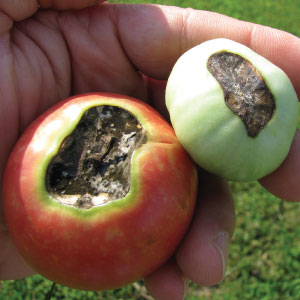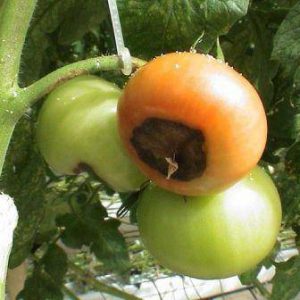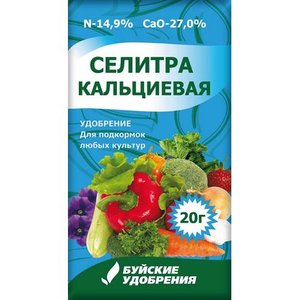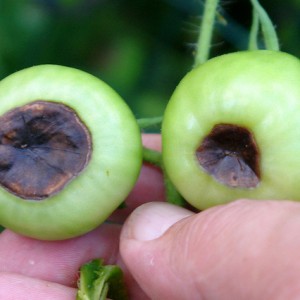How to get rid of top rot: proven drugs and folk remedies
Tomato is rightfully considered the king of the beds. The plant gives tasty healthy fruits and decorates garden plots. How pleasing to the eye even pinkish or bright ripe tomatoes!
But what if the tops of the tomatoes, where the ovary was, began to darken? How to save tomatoes from top rot? The answers are in the article.
The content of the article
What is Top Rot
 Tomatoes are often subject to a disease such as top rot. The disease affects plants both in greenhouses and in the open field.
Tomatoes are often subject to a disease such as top rot. The disease affects plants both in greenhouses and in the open field.
Rot spreads quickly and can destroy the entire crop in a few days.
Fruits with signs of spoilage are not suitable for food and for harvesting. You cannot collect seeds from such tomatoes.
Top rot, or "top" - a disease of non-infectious nature. A pathological process occurs due to improper care and unfavorable weather conditions.
Signs of appearance
It is not easy to detect a disease at an early stage of development. Only upon close examination can you notice that watery dark green spots have appeared on the tops of the fruits (where there was a flower). Over time, the skin dries up and they acquire a dark brown color, tissue necrosis is aggravated.
Top rot appears mainly on unripe tomatoes. Further growth of fruits stops, they turn red earlier than healthy ones and soon fall off.
Fungi and bacteria settle on the tissue affected by rot, penetrate deep into the fetus. The pulp rots, the seeds become infected.
Important! It is because of the secondary infection with pathogenic microorganisms that inexperienced gardeners consider apical rot an infectious disease. But the reasons lie elsewhere.
Reasons for the appearance
The physiological basis of apical rot is a lack of calcium in tomato tissues.
Calcium is involved in the processing and assimilation of nutrients (such as starch and protein) and promotes nitrogen absorption.
Calcium ions are part of the cell walls. The lack of this element leads to cell deformation, the formation of weak integumentary tissues.
Calcium is inactive in soil and plant tissues. In the organs of the bushes, it is distributed exclusively by the flow of transpiration - the physiological evaporation of water.
After being absorbed by the roots, the ions move to the parts that most actively evaporate moisture. In tomatoes, these are mature leaves. The element is not redistributed throughout the plant and cannot move from large leaves to young ones. Fruits evaporate less or do not evaporate water at all, therefore calcium deficiency is primarily manifested on them.
Factors leading to calcium deficiency are varied:
- Insufficient watering during the period of mass formation and pouring of tomatoes provokes stress. Evaporating leaves pull moisture away from the ovaries, and with it the necessary trace elements.
- Hot weather enhances transpiration and growing tomatoes are left without water and calcium dissolved in it.
- Acidified soil contains few calcium ions in the form available to plants.
- In saline soils, the balance of minerals is disturbed. So, with an excess of potassium, sodium and magnesium, the absorption of calcium by the roots of tomatoes slows down. Boron deficiency negatively affects the degree of assimilation by plant tissues.
- Excess nitrogen in the ammonium form weakens the ability of ions to penetrate the roots.
Varietal characteristics also affect the development of top rot. This disease is more often exposed to large-fruited or elongated fruits of tomatoes, as well as early-ripening varieties.
Disease control measures
The only way to cure a tomato from top rot is to saturate the plant with calcium.
First of all, you need to remove damaged fruits from the bushes and destroy outside the site, because dead tissue is an ideal breeding ground for various pests.
To maintain the water-salt balance, an irrigation regime is established so that the soil has time to dry out no more than 2-3 cm deep.
When growing tomatoes in greenhouses, additional ventilation is carried out, the doors of greenhouses are left open at night.
How to treat tomatoes from top rot in open ground and in a greenhouse
With a lack of calcium in the soil or its inaccessibility due to an imbalance of minerals, emergency foliar dressing with instant calcium fertilizers is used.
Experienced vegetable growers recommend using one of the following means:
- "Calcifol 25" - a water-soluble powder with a calcium content of 25% in terms of oxide. The element is present in the preparation in the form of acetate, easily assimilated by the plant. The fertilizer does not contain nitrates and chlorides, therefore it is not toxic and does not lead to the growth of green mass. To prepare the solution, take 2-5 g of the drug per 1 liter of water. The leaves are sprayed 3-5 times from the moment the ovaries appear with an interval of 7-10 days.

- "Brexil Sa" - fertilizer with boron additive, calcium content - 15%, boron - 0.5%. Boron increases the mobility of calcium and promotes mutual absorption. The elements are linked into organic complexes that are biologically compatible with tomato tissues. Treatments are carried out with a 0.2% solution every 10-15 days after abundant watering.
- "Calcium nitrate" (calcium nitrate). Nitrate nitrogen in the composition of the drug helps to penetrate calcium into cells. The addition of boric acid enhances the effect of the substance. To obtain a working fluid, take 20 g of calcium nitrate and 10 g of boric acid per 10 liters of water. Leaves are processed once every two weeks.
How to get rid of folk methods
Ash solution is a recognized folk remedy for top rot. Wood ash is rich in calcium, phosphorus and other beneficial elements.
The solution is prepared as follows: the ash from burning wood or plant residues is sieved, two glasses of powder are poured with a liter of boiling water, insisted for about 30 minutes until the mixture cools down. The resulting infusion is mixed with 10 liters of irrigation water.
Pour 1 liter of the product under the root of each tomato.
You can also carry out leaf dressing, after adding 50-60 g of grated laundry soap per 10 liters of ash solution.
Disease prevention
Disease can be prevented by providing tomato bushes with the required amount of available calcium.
Regular abundant watering during mass setting and pouring of fruits will help in this. Do not forget about loosening. Loose soil retains moisture better and promotes the movement of trace elements. Mulching the beds is no less effective.
Calcium fertilizer prophylaxis is difficult. It is difficult to predict how many such fertilizers will be needed for the same plot per season. The assimilation of calcium depends on the amount of precipitation, crop load, and the introduction of organic matter.
Important! Excess calcium is no less harmful than lack of calcium. With an excess of iron, it becomes inaccessible to plants, the assimilation of nitrogen, potassium, boron worsens; alkalization of the soil occurs, which most crops cannot tolerate.
The optimal solution would be foliar feeding with water-soluble forms of calcium. At the end of flowering, after the formation of ovaries, 3-4 treatments are carried out with intervals of 7-10 days. If top rot was observed in the previous season, the number of sprays is increased to 5-6 per season.
How to spray tomatoes is described in the previous section.
Presowing seed preparation
Treating tomato seeds before planting is not directly related to the prevention of top rot.
However, if the seed is in doubt or purchased in an unreliable place, disinfection is mandatory. The seeds collected from the spoiled "top" of the fruit are probably infected with pathogenic microorganisms.
For etching, a slightly pink (a few crystals per glass of water is enough) solution of potassium permanganate is used. The seeds are placed in a gauze knot and immersed in a glass for 15-20 minutes. Then the seeds are removed and dried.
A solution of copper sulfate is used as a disinfectant. 2 g of the drug is diluted in one liter of warm water. The seeds should lie in such a solution for 24 hours, after which they are removed and dried.
Top Rot Resistant Tomato Varieties
Breeding has made it possible to create tomatoes that are immune to top rot.
Hybrids are particularly resistant. It is worth paying attention to:
- Bolshevik F1 - early maturing determinant hybrid. Fruits are rounded flattened red, weighing up to 200 g. Taste qualities are excellent.
- Benito F1 - a high-yielding mid-season hybrid of the standard type. Fruits are medium-sized plum-shaped. The color is deep red.
- Pharaoh F1 — indeterminate mid-season tomato, tolerates a lack of moisture well. Fruits of medium size, weighing up to 150 g, differ in keeping quality.
Growing hybrids and varieties that are resistant to diseases will make it easier to care for and will delight you with a rich harvest.
Read also:
Why does gray rot appear on cucumbers and how to deal with it.
Conclusion
Crop losses due to top rot can be catastrophic. The reason for the dying off of the fruit tip is a lack of calcium. The factors leading to a deficiency of this element can be poor watering, hot weather, and an unbalanced mineral composition of the soil.
The disease manifests itself at first in the form of small watery dark green specks on the tips of the fruit, which eventually turn into necrotic areas of dark brown color. Damaged tomatoes attack pathogenic bacteria and fungi. They become unsuitable for food and for preparations.
Foliar top dressing with calcium fertilizers, timely watering, selection of disease-resistant varieties will help to grow an excellent tomato harvest.